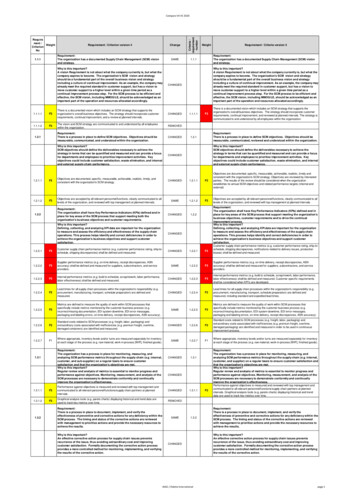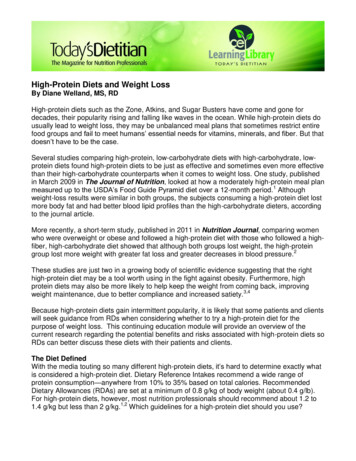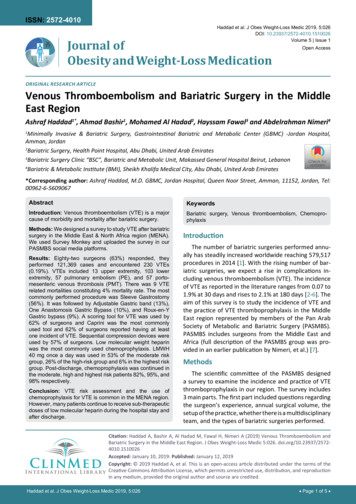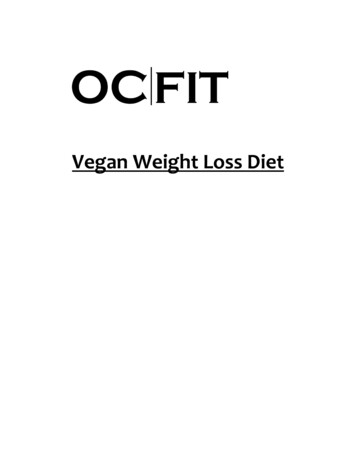
Transcription
Tryptophan Administration mayEnhance Weight Lossby Some Moderately ObesePatients on a Protein-SparingModified Fast (PSMF) DietEric Heraief, M.D.Peter Burckhardt, M.D.Judith J. Wurtman, Ph.D.Richard J. Wurtman, M.D.Drugs thought to enhance serotonin-mediated neurotransmission have beenshown to diminish appetite for carbohydrates. Therefore, we examined theability of tryptophan (TRP), serotonin's amino acid precursor, or a placebo toinfluence weight loss among 62 obese- Swiss outpatients who were on a re ducing diet [the Protein-Sparing Modified Fast (PSMF)Diet] which can be associated with severe carbohydrate craving. This diet provides relatively largeamountsof protein (1.2-1.4 glkg ideal body weight/day)but licclecarbohy-drate (40 glday or less), thus stimulating ketone body production. Its consumption also reduces the ratioof plasma TRPto the summed concentrationsof the other large neutral amino acids, thereby probably diminishing brainTRPand serotoninlevels. Duringthe initialmonth of the PSMFdiet all patients received the placebo; thereafter 30 received TRP(750 mg, twice daily,orally, for 3 months) and 32 the placebo, according to a double-blind protoeo/.Among moderately obese patients (140-159 % of ideal weight; N is),the TRP significantly enhanced weight loss (p .05), especially during thefirsttreatmentmonth (3.4 :!: 2.8 vs 1.7 :!: 1.7kg lost;means:!: standardde-Eric Heraief, M.D., is a Fellow in the Departement de Medecine Interne, Centre HospitalerUniversitaire Vaudois. Peter Burdhardt, M.D., is a Professor in the Departement de MedecineInterne, Centre Hospitaler Universitaire Vaudois. Judith J. Wurtman, Ph.D., Research Associate, is a cell biologist and nutritionist who does research on brain mechanisms regulating foodintake at the Laboratory of Neuroendocrine Regulation, Department of Applied Biological Sciences, Masssachusetts Institute of Technology, Cambridge, MA 02139. Richard J. Wurtman,M.D., is Director of the Laboratory of Neuroendocrine Regulation. Reprint requests should beaddressed to Richard J.Wurtman, M.D., MfT, Room 25-604, Cambridge, MA 02139.- -
- - . - -- - - - -Heraief et al.262viation) but also during the fotal 3-month test period (2.6 :!: 2.3 vs 1.5 :!: 1.6kg lost/month). The TRPdidn't modify the reported adherence to the PSMFdiet. The partial efficacy of TRP among our moderately obese subjects doesnot presently justify its routine use as an adjunct to a PSMF diet. However,greater efficacy may be obtained with better patient selection and under metabolic conditions designed to amplify the uptake of TRP into the brain (i.e.,administration along with a carbohydrate).INTRODUCTIONSuccess in the long-term management of obesity requires both that thepatient lose weight during the period of active treatment and that he orshe develop patterns of eating which allow maintenance of this weightloss thereafter. Both phases are rendered more difficult if the patient suffers from inappropriate craving for foods rich in carbohydrates. A historyof such cravings can, in our experience, be elicited from most obese subjects presenting themselves for treatment at an obesity clinic (Wurtman& Wurtman, 1981; Wurtman et aI., 1981); moreover the tendency toundergo such cravings (and to snack excessively on carbohydrates) maybe exacerbated if the subject is placed on. a weight-reducing or weightmaintenance diet that severely restricts carbohydrates (Wurtman,Moses, & Wurtman, 1983).One such reducing diet is the Protein-SparingModified Fast (PSMF) Diet (Burckhardt et a1., 1980; Flatt & Blackburn,1974), which allows the subject relatively large quantities of protein [1.21.4 glkg of ideal body weight (IBW)/day] in order to sustain body musclemass, but which limits dietary carbohydrates to 40 glday (by restrictingor proscribing certain foods). The carbohydrate cravings may, in thesepatients, be mediated by diet-induced changes in the plasma amino acidpattern, which secondarily diminish the synthesis and release of serotonin within the brain. Consuption of protein-rich, carbohydrate-poormeals lowers the "plasma/tryptophan (TRP) ratio" [the ratio of the TRPconcentration to the summed concentration of other circulating largeneutral amino acids (I.:NAA)which compete with TRP for passage acrossthe blood-brain barrier (Crandall & Fernstrom, 1980; Fernstrom andWurtman, 1971;Fernstrom, Larin, & Wurtman, 1973; Fernstrom et aI.,1979; Wurtman, 1982)] well beyond its normal range (Heraief, Burckhardt, Mauron, Wurtman, & Wurtman, 1983), thereby diminishing theamounts of TRP available within brain neurons for conversion to serotonin. In our experience, the carbohydrate craving associated with thePSMF diet restricts this diets's overall success.The present study was designed to examine the possibility that givingobese patients supplemental TRP while they are following the PSMFdietmight enhance their weight loss, possibly by reducing their intake of
283Tryptophan Administrationproscribed carbohydrate:-rich foods. Presumably the supplemental TRPwould enhance the release of serotonin from brain neurons, a processwhich has been shown, in experimental animals (Wurtman & Wurtman,1977, 1979a,b) and in human subjects (Wurtman, 1983; Wurtman &Wurtman, 1981; Wurtman et aL, 1981)to diminish appetite for carbohydrates, selectively (that is, to reduce the ratio of carbohydrate to proteinin the foods chosen for consumption). That TRP administration can, indeed, enhance serotonin release within the human brain has been deduced from indirect studies showing elevated levels of serotonin'smetabolite 5-hydroxyindoleacetic acid (5-HIAA) in cerebrospinal fluid(Gilman, Bartlett, Bridges, Kantameni, & Curzen, 1980), and changes insleep onset (Hartmann, 1977; Hartmann & Spinnweber, 1979; Wyatt etaL, 1970), sleepiness (Lieberman, Corldn, Spring, Growdon, & Wurtman, 1982), and mood (Coppen, Herzberg, & Magga, 1967;Fernstrom etaL, 1979; Lieberman et aL, 1982).DI-fenfluramine (Wurtman & Wu man, 1981;J.Wurtman et aL, 1981)and d-fenfluramine (Hirsch et aI., 1982; R. Wurtman, 1983;J. Wurtman,et aL, 1985), drugs that release serotonin into brain synapses, have beenfound to be highly effective in diminishing carbohydrate snacking amonginpatients receiving them for 2 weeks. Since the present study used outpatients who came to the clinic only at intervals of 2 or 4 weeks, it wasnot possible for us to measure directly the effects of the TRP on the selection of particular foods or nutrient ; hence our study focused on theassociated changes in body weight. The obese subjects were classifiedinto three groups, according to their degree of obesity, since patientswith an initial weight of 150% or more of ideal body weight (IBW)exhibita tendency to adhere to the PSMF diet with a better compliance, and subsequently to lose more weight (Heraief & Burckhardt, 1982; Iselin &Burckhardt, 1982).MATERIALSAND METHODSSubjects and DietSubjects were obese Swiss outpatients treated at the Obesity Clinic ofthe Hospital of the University of Lausanne; they either came to the clinicspontaneously or were referred by their physician. They weighed morethan 120% of the IBW(New York Metropolit n Life Insurance Co., 1959).All were asked to adhere to a PSMF.diet(Burckhardt et al., 1980),by consuming relatively large quantities of lean meat, fish, fowl, and eggs (orrestricted amounts of low-fat dairy products) and restricting their carbohydrate intake to selected vegetables and salads. [This diet provides 1.2g proteinlkg of IBW/day for women and 1.4 glkg of IBW/day for men,along with less than 40 gI day of carbohydrate and 10-20 glday of fat. Sub-
284Heraief et al.jects also take 12-24 mmol of potassium chloride per day and multivitamin preparations three times per week. The present of ketonuria isconfirmed three times weekly (Ketostix, Ames).] Subjects also agreed toparticipate in a prospective study on the weight-reducing effect of a concentrated nutrient, normally present in the diet (Le., TRP), that mightsuppress their craving for carbohydrates. (They were not told that theywould be receiving a placebo for part or all of the study.) Subjects werescreened for metabolic or endocrine disease before being admitted to thestudy. Of the 103who were allowed to enroll (91 women and 12 men), 41were withdrawn before its conclusion; three included 24 who failed tokeep clinic appointments, 11 for whom there was evidence of erratic dosing with TRP or with placebo, and 6 who had been consuming a PSMFdiet immediately before the time that they would have entered the study.Subjects were questioned about their tendency to experience a need tosnack on carbohydrate-rich foods, at particular times of day. Most acknowledged this propensity. Thereafter they were asked to take a commercial instant coffee mix (Nescafe Gold, Nestle Co., Vevey,Switzerland), to which TRP (750 mg) or a placebo had been added. Thetest coffee drink was to be consumed twice daily, 30-60 min before theircharacteristic time of carbohydrate craving. (If this time could not beidentified, the subject was instructed to take the beverage at least 60 minafter lunch and after dinner.) Quinine (15 mg) was added to the placebocoffee preparation in order to mimic the slightly bitter taste of the preparation that contained TRP. Patients were allowed to add artificial sweeteners and/or 1-2 teaspoons of low fat milk to the coffee. Three of thepatients who refused to take a coffee-contai ng preparation were allowed to receive the TRP or its placebo (diatomaceous earth) in capsules(three each, twice daily). The protocol was approved by the ethical committee of the hospital.Subjects returned to the clinic at least once each month, to be weighedand questioned about their compliance with the diet and experimentalprotocol. Compliance was rated subjectively (by the dietician and/or physician), and by the presence or absence of ketonuria on a scale of 0 (poor),1 (moderate), or 2 (good): in the poor compliance group (0), patients followed any diet; with moderate compliance (1), patients ate too much carbohydrate to sustain ketosis. Only patients who strictly adhered to thePSMF diet received the rating score of 2. During the first month of dieting, a period during which subjects generally tend to lose weight mostrapidly, all consumed the placebo preparations. Thereafter, following adouble-blind protocol, half received the TRP and half the placebo. Attending physicians and dieticians were not informed about the identitiesof the preparations being taken; however, an external physician who hadaccess to the treatment code assigned subjects to placebo or TRP betweenthree groups so as to equalize their distributions on the basis of their degree of obesity: mild (less than 139% of IBW), moderate (140-159%), and
285Tryptophan Administrationsevere (more than 160%). Thirty patients receiving TRP (23 females and7 males) and 32 receiving placebo (30 females and 2 males) remained inthe study long enough to allow use of data on their weight loss.Unless otherwise indicated all data are given as means :t standard de'viations. Mean values are compared using paired or unpaired Student'st tests; proportions of responding subjects in TRP and placebo groups are.compared using chi-square analysis.RESULISThe TRP and placebo groups did not differ in sex distribution, in meanage, nor in initial weight expressed as percent of IBW (taken from the tables of the Metropolitan Life Insurance Co., 1959)(Table 1). [The absoluteinitial weight of the placebo group was less than that of the subjects receiving TRP (p .02).] The mean duration of treatment (2.4 months) alsodid not differ between placebo and TRP groups. After the third month ofthe double-blind trial (i.e., the fourth month of the study) too few patients remained in each group to allow statistical analysis, hence data arepresented only for the initial placebo month and the subsequent 3months of TRP or placebo (Fig. 1).Each patient's weight loss was- examined as a function of month oftreatment, nature of treatment (placebo vs TRP), and degree of compliance and obesity. As anticipated (Heraief & Burckhardt, 1982),the greatest weight loss was observed during the first month (4.1 :t 1.9 g kg in theplacebo group and 3.8 :t 1.7 kg in the group subsequently receivingTRP), when all subjects were receiving placebos. During the secondmonth (the first actual treatment month), weight loss averaged 2.5 :t 2.'1kg for subjects taking the .placebo and 2.9 :t 2.3 kg for those receivingTRP. During the next 2 months, weight losses were 2.4 :t 1.6 and 1.6 :tTable 1. Characteristics of placebo and tryptophangroups.aSex distributionFemaleMaleAge (years)Initial weight) (kg)(% IBWb)Reported CHO craving(YeslNo)PlaceboTRP30240.2 14.883.9 11.9148.2 15.323741.9 11.390.9 14.7 152.2 18.4aData in all tables are expressed as means3012 25/5standard deviations.bAct lUll weightlldeal weight x 100. IdeJlI body weight is taken from tablesof the Metropolitan Life Insurance Co., 1959. p . .02differs from placebogroup.
286Heraief et al.DURATION OF THE FOLLOW-UPPLACEBOTRYPTOPHANFigure 1. Duration of followup for placebo and tryptophan group. Open barsindicate numbers of subjects in each group during the initial placebo month(Month 1); shaded bars indicate number of subjects remaining within each groupat the end of the treatment month indicated, during the 3 months of the treatmentperiod.1.9 kg, respectively, in the placebo group and 2.0 :t 1.8 and 2.0 :t 1.2 kgin the TRP group. Thus analysis-of data for the entire subject population(including subjects whose compliance was so poor that they gainedweight during the study) failed to display treatment effects. In general,the extent of each subject's compliance tended to parallel his or herweight loss.We reanalyzed our data by determining whether TRP was more likelyto be effective in (a) those with more or less severe obesity and (b) subjects with moderate or good compliance.Although the extent of compliance correlated with weight loss duringthe initial treatment month, both among subjects receiving placebo andthose taking TRP (Table 2), TRP did not produce significantly moreweight loss than its placebo in any patient group segregated according toits degree of compliance. .In contrast, segregation of subjects by severity of obesity did allowdemonstration of a significant TRP effect among the moderately obesegroup (Table 3). The initial weights of our subjects varied between 123and 196% of IBW. For assessing possible relationships between the extent of the initial obesity and the subject's responsiveness to TRP, weclassified each patient as mildly obese (less than 140% of IBW; N 18);moderately obese (between 140 and 159% of IBW; N 25); or severely 19). The moderatelyobesesubjectsobese (more than 159%of IBW;N
- - - .-287Tryptophan AdministrationTable 2. Relation between subject compliance and weight loss after placebo orTRP.GroupAge (years)Initial Weight (kg)(% IBW)Weight loss (kg)Month 1 (placebo)Month 2Month 3Month 4Mean (Months 2 )Compliance 1PlaceboTRP39.6 :t 13.382.6 :t 8.9147 :t 13(2013.6:t(2012.0:t(1211.7:t(7)1.2 :t1.8 :t1.71.01.41.21.241.8 :t 13.586.9 :t 12.1152 :t 18(1613.4:t .1.9(1612.4:t 1.5(911.7:t 1.3(612.0:t 1.51.9 :t 1.4Compliance 2bPlaceboTRP42.7 :t 15.885.1 :t 17.6152 :t 19(1015.4:t(1014.2:t(813.7:t(512.4:t3.6 :t1.7 2.4 1.()I1.01.8 43.3 :t 8.898.5 :t 16.9156 :t 19(1114.7:t 1.5"(1114.7:t2.4"(1012.4:t 2.0(612.4:t 0.93.5 :t 2.2"-Compliance 1: Mild adherence to the PSMF diet (patients followed a hypoadoric diet but consumedsome disallowed foods).bCompliance 2: Strict adherence to the PSMF diet, prescribed. Numbers in parentheses indicate groupsize. I' .001 differsfromco"espondingcompliance1groupfor placebotreatment."1' .001 differs-from espondingcompliance 1 group for TRP treatment.showed equivalent weight losses during the initial placebo month. However, during the second month they lost significantly more weight (p - .05)on TRPthan on the placebo (Table3). This tendency was sustained,but differences were not statistically significant beyond the secondmonth, possibly because of the small size of the gro ps by this time.Overall weight loss for the 3-month treatment period was significantlygreater among patients recei ng TRP (2.6 :t 2.3 kg; range, 1.6-13.3 kg)than among those on the placebo (1.5 :t 1.6 kg; p .04; range,0.3-4 kg).The severelyobesepatients who subsequently took placebo tended tolose more weight during the initial placebo month than those who subsequently took TRP, largely because of two particular patients who complied with the diet especially well, losing 17 and 25 kg, respectively, fromthe time they started the PSMF diet. During the third month the averageweight loss of the placebo group was again significantly greater than thatfor the TRP"group, again because of the contribution of "these two patients. However, overall weight loss during the 3-month treatment period did not differ significantly between severely obese patients 'on theplacebo (2.9 :t 1.9 kg; range, 1.4-10.3 kg) and those on TRP (2.4 :t 1.7kg; range, 0.5-9.7 kg). The mildlyobesepatients tended to drop out of thestudy before sufficient data could be collected to evaluate TRP's effect.No significant differences were observed between the placebo- and TRPtreated groups.Since so large a proportion of our patients claimed a tendency to carbohydrate craving (94% of the placebo group and 83% of the TRP group;Table 1), WI;!were unable to use tbis characteristic as a means for sepa-
Nex ex Table 3. Relation between severity of obesity and weight loss after placebo or TRP.Mild.Obesitr GroupAge (years)Initial weight (kg)Weight loss (kg/month)Month 1 (Placebo)Month 2Month 3Month 4Mean (Months 2-4)ModeratebPlacebo31.5 :t 13.873.7 :t 6.0(10)3.9:t 1.7(10)3.1:t 1.7-TRP39.8 :t 11.378.6 :t 8.3(8)3.5:t 1.7(8)1.8:t 1.8-Placebo42.6 :t 13.083.0 :t 7.5(13)3.5:t 1.8(13)1.7:!: 1.7(10)1.7:!: 1.7(1)().9:t 1.41.5 :t 1.6SeverebTRPPlacebo40.0 :t 12.091.4 :t 14.546.5 :t 13.0%.3 :t 11.7(12)3.6:t 1.7(12)3.4:t 2.83(9)1.8:t 1.7(6)2.1:t 1.42.6 :!: 2.33(9)5.2:!: 1.8(9)3.2:t 2.6(7)3.4:t 1.0(6)2.0:t 1.32.6 :!: 1.9TRPSO.O:t 10.3100.4 :t 12.2(10):t(10)3.3:t(9)2.0:t(4)2.3:t2.4 :t2.01.81.4 1.71.7.Obesity is classifiedt;lccordingto initialweightas percentof IBW. "Mild" obesityis between120and 139%of IBW; "moderate"obesityis between140and 159%;"StVe1'e"obesityis 160%or aver.Partntheses indicsztenumbers of subjects remaining in study." .05 differs from corresponding placebo group.
------289Tryptophan Administrationrating those who might or might not respond to TRP. Among the groupas a whole, 55% described a decrease in their carbohydrate craving during the initial month of the study when all were receiving the placebo.DISCUSSIONThese data show that, in a heterogeneous group of obese outpatients,supplemental oral TRP, studied in a double-blind protocol, could enhance weight loss in some patients, and that potential responders couldbe identified, prospectively, based on the degree of initial obesity ("moderate"; 140-159% of IBW). Patients may have been especially responsiveto TRP because they were concurrently on a reducing diet (PSMF) thatcan cause carbohydrate craving and that produces changes in the plasmaamino acid pattern indicative of diminished brain serotonin synthesis(Heraief et aI., 1983;Wurtman, 1982). However obesity per se apparentlyalso reduces the "plasma TRP ratio" (Heraief et aL, 1983), probably by increasing basal plasma levels of the branched-chain amino acids (Heraiefet aL, 1983) and decreasing their decline in response to insulin. Henceobese patients as a group might tend to have lower brain TRP and serotonin levels than the nonobese.In our study, as in previous studies using TRP to suppress'food intake(Wurtman & Wurtman, 1981;Wurtman et aL, 1981), only about 35-45%of the total population appeared to respond to the amino acid. A somewhat larger proportion (60-65%) tends to respond to fenfluramine, adrug that acts presynaptically to release brain serotonin into synapses(Garattini, Jori, Buczko, & Samamin, 1975). A prior study on outpatientsconsuming unit-sized portions of carbohydrate-rich snacks ad libitumhad shown that 4 of 11 such subjects (36%) reduced snack intake significantly when receiving TRP (Wurtman & Wurtman, 1981); in anotherstudy using inpatients allowed to choose carbohydrate-rich or proteinrich snacks ad libitum from a vending machine, three of eight patients(38%) were ''TRP-responders'' (Wurtman et a1., 1981).In contrast, 64 and67%, respectively, of fenfluramine-treated subjects showed significantdecreases in carbohydrate snacking in these two studies (Wurtman &Wurtman, 1981;Wurtman et a1., 1981).The mechanisms that cause someobese patients not to respond to therapi s directed at releasing morebrain serotonin, and those that caused the drug to be more effective thanthe nutrient amino acid, have not been daIified. The lower response rateto.TRP than to fenfluramine may reflect the etiologic heterogeneity ofobesity, some patients perhaps having deficient serotonin-mediatedneurotransmission, possibly with carbohydrate-craving, and some not.U may also be, in part, a motivational artefact, the mildly obe lackingsufficientincentive to remain on a restrictivediet, and the severely obese
-- --------- -- - - -----Heraief et al.290needing no additional drug or "TRP effect" to commit themselves to thatdiet.The response rate that we observed could reflect special problems associated with the design of our study, e.g., the fact that we saw our patients only once each 2 or 4 weeks; that we had no direct observations ofwhat and how much they ate and whether they actually complied withthe diet or the TRP regimen most of the time, and that, as discussed below, we were unable to give the TRP along with some carbohydrate,which would be expected to enhanceits brain uptake by lowering plasmalevels of its competitors (Crandell & Fernstrom, 1980). Instead, we gavethe TRP after meals which were rich in these competing amino acids.Conceivably an obesity-management program in which each patient'sTRP intake is individualized and in which patients are accepted only iftheir obesity is "moderate" and their apparent motivation good, but inneed of buttressing, may show a greater degree of TRP responsiveness.The TRP dose that we administered (750 mg p.o. twice daily) was lowerthan that generally used to induce sleep (Wyatt et aI., 1970) or to treatdepression (Coppen et al., 1967; Moller, Kirk, & Freming, 1976). A I-gdose, given at the same time as in the present study (1 hour after a meal),increased plasma TRP levels and the plasma TRPILNAA ratio by 150200% after 2 hours among subjects consuming a PSMF diet; however, theplasma TRPILNAA ratio was not significantly elevated beyond that seenin the same subjects after an overnight fast while on a normal diet (Heraief et al., 1983). Most likely, much greater increases in the plasma TRPratio would have been produced had we been able to give the TRP alongwith an insulin-releasingcarbohydrate; the. protocol of the PSMF dietprecluded administering this combination. We elected to use a relativelysmall TRP dose in order to minimize such reported TRP side-effects assleepiness and because higher doses can, by diminishing the plasma tyrosine ratio, impair brain catecholamine synthesis (Wurtman, Larin, Mostafapour, & Fernstrom, 1974). We also included caffeine in our TRP andplacebo preparations in order to reduce whatever mid-day sleepiness theTRP might produce; none of our patients complained of sleepiness or fatigue as a side effect of the amino acid, nor were there any other reportedside effects.In conclusion, a moderate dose of TRP significantly enhanced weightloss among some moderately obese patients on a PSMF diet. The effectwas not sufficiently consistent to justify routine TRP supplementationwith this diet. Nevertheless, the partial efficacy observed in this studysuggests that TRP might be more effective when given to selected populations of obese people, perhaps along with carbohydrates.We thank Dr. Pierre Hirsbrunner of NESTEC,who prepared the TRP-containingand placebo coffee mixtures; Dr. Roland Moeri, of Centre Hospitalier Universi.taire Vaudois,who assisted in patient management;and Dr. YvesIngenbleekof
291Tryptophan AdministrationNESTEC, who managed the double-blind code. These studies were supported bygrants from NESTEC, Vevey, Switzerland; the National Institutes of Health andthe National Aeronautics and Space Administration, USA; and the Franz JosephFoundation, Switzerland.REFERENCESBurckhardt, P., Jequier, E., Iselin, H. V., Delaloye, B., Meyer, H. V., Rousselle, J., &:Viano,M. C. (1980). Le traitement de l'obesite par Ie regime PSMF. Medecineet Hygiene,38,2144-2153.Coppen, A., Herzberg, B., &:Magga, R. (1967).Tryptophan in the treatment of depression.Lancet,2, 1178-1180.Crandall, E. A., &:Fernstrom, J. D. (1980).Acute changes in brain tryptophan and serotoninafter carbohydrate or protein ingestion by diabetic rats. Diabetes,29, 460-466.Fernstrom, J. D., Larin, F., &:Wurtman, R. J. (1973).Correlations between tryptophan andplasma neutral amino acid levels following food consumption in rat. Life Sciences,13,517-524.Fernstrom, J. D., &:Wurtman, R. J. (1971). Brain serotonin content: Increase followingingestion of carbohydrate diet. Science,174, 1023-1025.Fernstrom, J. D., Wurtman, R.J., Hammerstrom-Wiklund, B., Rand, W. M., Munro, H. N.,&:Davidson, D. S. (1979).Diurnal variations in plasma concentration of tryptophan, tyrosine and other neutral amino acids: Effect of dietary protein intake. Ameriam Journalof Cliniall Nutrition, 32, 1912-1922.Flatt, J. P., &:Blackburn, G. L. (1974). The metabolic fuel regulatory system: Implicationsfor protein spariog therapies during Ioric deprivation and disease. AmericanJournalofCliniatl Nutrition, 27, 175-187.Garattini, 5., Jori, A., Buczko, W., &:Samamin, R. (1975).The mechanism of action of fenfluramine. PostgraduateMediallJournal(Suppl. 1),51,27-35.Gilman, P. K., Bartlett, J. R., Bridges, P. K., Kantameni, B. D., &:Curzon, G. (1980).Relationships between tryptophan concentrations in human plasma cerebrospinal fluid andcerebral cortex following tryptophan infusion. Neuropluzrmacology,19, 1241-1242.Hartmann, E. (1977).L-tryptophan as an hypnotic agent: A review. Wakingand Sleeping,1,55-161.Hartmann, E., &:Spinnweber, C. L. (1979).Sleep induced by I-tryptophan. Effectsof dosages within the normal dietary intake. ef, E., &:Burckhardt, P. (1982).Compliance and results with protein sparing modifiedfast in 115outpatients (abstract). InternatiomllJournalfor Vitaminand Nutrition Research,52, 211.Heraief, E., Burckhardt, P., Mauron, c., Wurtman, J. J., &:Wurtman, R.J. (1983).The treatment of obesity by carbohydrate deprivation suppresses plasma tryptophan and its ratioto other large neutral amino acids. Journalof NeuralTransmission,57, 187-195.Hirsch, J. A., Goldberg, S., &:Wurtman, R. J. (1982).Effectof ( )- or (-)- enantiomersof fenfluramine or nonfenfluramine on nutrient selection by rats. , H. V., &:Burckhardt, P. (1982). Balanced hypocaloric diet versus protein-sparingmodified fast in the treatment of obesity: a comparative study. InternationalJournalofObesity,6, 175-181.Ueberman, H. R., Corkin, 5., Spring, B.J., Growdon, J. H., &:Wurtman, R.J. (1982).Moodand sensimotor performance after neurotransmitter precursor administration (abstract).Societyof Neuroscience,8, 395.Moller, S. E., Kirk, L., &:Freming, K. H. (1976). Plasma amino acids as an index forsubgroups in manic depressive psychosis. Correlation to effect of tryptophan. Psychopharmacologia,49, 205-213.New York Metropolitan Ufe Insurance Co. (1959). New weight standard for men andwomen. Statistiatl Bulletin,40, 1-4.Wurtman, R. J. (1982).Nutrients that modify brain function. ScientificAmerialn, 246,42-51.
292Heraief et a!.Wurtman, R. J. (1983).Behavioral effects of nutrients. Lancet,1, 1145-1147.Wurtman, R. J., Larin, F., Mostafapour, S., &:Fernstrom, J. D. (1974).Brain catechol synthesis: Control by brain tyrosine concentration. Science185, 183-184.Wurtman, J. J., Moses, P. L., &:Wurtman, R. J. (1983).Prior carbohydrate consumption affects the amount of carbohydrate that rats choose to eat. fournalofNutrition, 113, 70-78.Wurtman, J. J., &:Wurtman, R. J. (1977). Fenfluramine and fluoxetine spare protein consumption while suppressing caloric intake by rats. Science,198, 1178-1180.Wurtman, J. J., &:Wurtman, R.J. (1979a).Fenfluramine and other serotoninergic drugs depress food intake and carbohydrate consumption while sparing protein consumption.CurrentMedicalResearchand Opinion(Suppl. 1), 6, 28-33.Wurtman, J. J., &:Wurtman, R.J. (1979b).Drugs that enhance central serotoninergic transmission diminish elective carbohydrate consumption by rats. Journalof PharmJlcyandPharmJlcology,34, 18-21.Wurtman, J. J., &:Wurtman, R. J. (1981). Suppression of carbohydrate consumption atsnacks and at mealtime by DI-fenfluramine or tryptophan. In S. Garattini &:R. Samamin, (Eds.), Anorecticagents:Mechanismsof actionand tolerance(pp. 169-182).New York:Raven Press.Wurtman, J. J., Wurtman R. J., Growdon, J. H., Henry, P., Lipscomb, A., &:Zeisel, S. H.(1981).Carbohydrate craving in obese people: Suppression by treatments affecting serotoninergic transmission. Internationalfournalof EatingDisorders,1, 1-15.Wurtman, J., Wurtman, R., Mark, S., Tsay, R., Gilbert, W., &:Growdon, J. (1985).d-Fenfluramine selectively suppresses carbohydrate snacking by obese subjects. InternationalJournalof EatingDisorders,4, 89-99.Wyatt, R. J., Kupfer, D. J., Sjoerdsma, A., Engelman, K., David, H. F., &:Snyder, F. (1970).Effects of L-tryptophan (a natural sedative) on human sleep. Lancet,2, 842-845.
maintenance diet that severely restricts carbohydrates (Wurtman, Moses, & Wurtman, 1983). One such reducing diet is the Protein-Sparing Modified Fast (PSMF) Diet (Burckhardt et a1., 1980; Flatt & Blackburn, 1974), which allows











